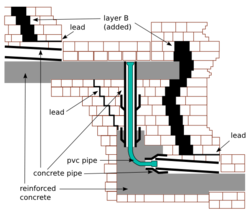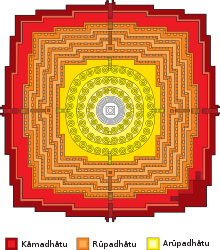Construction

Buddhist pilgrims meditate on the top platform
There is no written record of who built Borobudur or of its intended purpose.
The construction time has been estimated by comparison between
carved reliefs on the temple's hidden foot and the
inscriptions commonly used in royal charters during the 8th and 9th centuries. Borobudur was likely founded around 800 AD.
This corresponds to the period between 760 and 830 AD, the peak of the
Sailendra dynasty in central Java,
when it was under the influence of the
Srivijayan Empire. The construction has been estimated to have taken 75 years and been completed during the reign of
Samaratungga in 825.
There is confusion between Hindu and Buddhist rulers in
Java around that time. The Sailendras were known as ardent followers of Lord Buddha, though stone inscriptions found at Sojomerto suggest they may have been Hindus.
It was during this time that many Hindu and Buddhist monuments were built on the plains and mountain around the Kedu Plain. The Buddhist monuments, including Borobudur, were erected around the same time as the Hindu
Shiva Prambanan temple compound. In 732 AD, the Shivaite King
Sanjaya commissioned a
Shivalinga sanctuary to be built on the Ukir hill, only 10 km (6.2 miles) east of Borobudur.
Construction of Buddhist temples, including Borobudur, at that time was possible because Sanjaya's immediate successor,
Rakai Panangkaran, granted his permission to the Buddhist followers to build such temples.
In fact, to show his respect, Panangkaran gave the village of
Kalasan to the Buddhist community, as is written in the Kalasan Charter dated 778 AD.
This has led some archaeologists to believe that there was never serious conflict concerning religion in Java as it was possible for a Hindu king to patronize the establishment of a Buddhist monument; or for a Buddhist king to act likewise.
However, it is likely that there were two rival royal dynasties in Java at the time—the Buddhist Sailendra and the
Saivite Sanjaya—in which the latter triumphed over their rival in the 856 battle on the
Ratubaka plateau.
This confusion also exists regarding the Lara Jonggrang temple at the
Prambanan complex, which was believed that it was erected by the victor Rakai Pikatan as the Sanjaya dynasty's reply to Borobudur,
but others suggest that there was a climate of peaceful coexistence where Sailendra involvement exists in Lara Jonggrang.
Abandonment
Borobudur lay hidden for centuries under layers of
volcanic ash and jungle growth. The facts behind its abandonment remain a mystery. It is not known when active use of the monument and Buddhist pilgrimage to it ceased. Somewhere between 928 and 1006, the center of power moved to the
East Java region and a series of volcanic eruptions took place; it is not certain whether the latter influenced the former but several sources mention this as the most likely period of abandonment.
Soekmono (1976) also mentions the popular belief that the temples were disbanded when the population converted to Islam in the 15th century.
The monument was not forgotten completely, though folk stories gradually shifted from its past glory into more
superstitious beliefs associated with bad luck and misery. Two
old Javanese chronicles (
babad) from the 18th century mention cases of bad luck associated with the monument. According to the
Babad Tanah Jawi (or the History of Java), the monument was a fatal factor for a rebel who revolted against the king of
Mataram in 1709.
The hill was besieged and the insurgents were defeated and sentenced to death by the king. In the
Babad Mataram (or the History of the Mataram Kingdom), the monument was associated with the misfortune of the crown prince of the
Yogyakarta Sultanate in 1757.
In spite of a taboo against visiting the monument, "he took what is written as
the knight who was captured in a cage (a statue in one of the perforated stupas)". Upon returning to his palace, he fell ill and died one day later.
Rediscovery

Borobudur's main stupa, which is empty and raised a mystery when discovered
Following the
Anglo-Dutch Java War, Java was under British administration from 1811 to 1816. The appointed governor was Lieutenant
Governor-General Thomas Stamford Raffles, who took great interest in the history of Java. He collected Javanese antiques and made notes through contacts with local inhabitants during his tour throughout the island. On an inspection tour to
Semarang in 1814, he was informed about a big monument deep in a jungle near the village of Bumisegoro.
He was not able to make the discovery himself and sent H.C. Cornelius, a Dutch engineer, to investigate.
In two months, Cornelius and his 200 men cut down trees, burned down vegetation and dug away the earth to reveal the monument. Due to the danger of collapse, he could not unearth all galleries. He reported his findings to Raffles including various drawings. Although the discovery is only mentioned by a few sentences, Raffles has been credited with the monument's recovery, as one who had brought it to the world's attention.
Hartmann, a Dutch administrator of the Kedu region, continued Cornelius' work and in 1835 the whole complex was finally unearthed. His interest in Borobudur was more personal than official. Hartmann did not write any reports of his activities; in particular, the alleged story that he discovered the large statue of Buddha in the main stupa.
In 1842, Hartmann investigated the main dome although what he discovered remains unknown as the main stupa remains empty.
The
Dutch East Indies government then commissioned F.C. Wilsen, a Dutch engineering official, who studied the monument and drew hundreds of relief sketches. J.F.G. Brumund was also appointed to make a detailed study of the monument, which was completed in 1859. The government intended to publish an article based on Brumund study supplemented by Wilsen's drawings, but Brumund refused to cooperate. The government then commissioned another scholar, C. Leemans, who compiled a
monograph based on Brumund's and Wilsen's sources. In 1873, the first monograph of the detailed study of Borobudur was published, followed by its French translation a year later.
The first photograph of the monument was taken in 1873 by a Dutch-
Flemish engraver,
Isidore van Kinsbergen.
Appreciation of the site developed slowly, and it served for some time largely as a source of souvenirs and income for "souvenir hunters" and thieves. In 1882, the chief inspector of cultural artifacts recommended that Borobudur be entirely disassembled with the relocation of reliefs into museums due to the unstable condition of the monument.
As a result, the government appointed Groenveldt, an
archeologist, to undertake a thorough investigation of the site and to assess the actual condition of the complex; his report found that these fears were unjustified and recommended it be left intact.
Contemporary events
Following the major 1973 renovation funded by
UNESCO,
Borobudur is once again used as a
place of worship and pilgrimage. Once a year, during the
full moon in May or June,
Buddhists in Indonesia observe
Vesak (
Indonesian:
Waisak) day commemorating the birth, death, and the time when
Siddhārtha Gautama attained the highest wisdom to become the Buddha Shakyamuni. Vesak is an official
national holiday in Indonesia
and the ceremony is centered at the three Buddhist temples by walking from
Mendut to
Pawon and ending at Borobudur.
The monument is the single most visited
tourist attraction in Indonesia. In 1974, 260,000 tourists of whom 36,000 were foreigners visited the monument.
The figure hiked into
2.5 million visitors annually (80% were domestic tourists) in the mid 1990s, before
the country's economy crisis.
Tourism development, however, has been criticized for not including the local community on which occasional local conflict has arisen.
In 2003, residents and small businesses around Borobudur organized several meetings and poetry protests, objecting to a provincial government plan to build a three-story mall complex, dubbed the 'Java World'.

"Mahakarya Borobudur" ballet performance at Borobudur
On 21 January 1985, nine stupas were badly damaged by nine bombs.
In 1991, a blind Muslim preacher, Husein Ali Al Habsyie, was sentenced to
life imprisonment for masterminding a series of bombings in the mid 1980s including the temple attack.
Two other members of a right-wing
extremist group that carried out the bombings were each sentenced to 20 years in 1986 and another man received a 13-year prison term. On 27 May 2006, an
earthquake of 6.2 magnitude on the
Richter scale struck the south coast of Central Java. The event had caused severe damage around the region and casualties to the nearby city of
Yogyakarta, but Borobudur remained intact.
On 28 August 2006 the
Trail of Civilizations symposium was held in Borobudur under the auspices of the governor of Central Java and the Indonesian Ministry of Culture and Tourism, also present the representatives from UNESCO and predominantly Buddhist nations of Southeast Asia, such as
Thailand,
Myanmar,
Laos,
Vietnam and
Cambodia. Climax of the event was the "Mahakarya Borobudur" ballet performance in front of the temple of Borobudur. It was choreographed to feature traditional Javanese dancing, music and costumes, and tell the history about the construction of the Borobudur. After the symposium, the Mahakarya Borobudur ballet is performed several times, especially during annual national
Waisak commemoration at Borobudur attended by Indonesian President.
UNESCO identified three specific areas of concern under the present state of conservation: (i) vandalism by visitors; (ii) soil erosion in the south-eastern part of the site; (iii) analysis and restoration of missing elements.
The soft soil, the numerous earthquakes and heavy rains lead to the destabilization of the structure. Earthquakes are by far the most contributing factors, since not only stones fall down and arches crumble, but the earth itself can move in waves, further destroying the structure.
The increasing popularity of the stupa brings in many visitors, most of whom are from Indonesia. Despite warning signs on all levels not to touch anything, the regular transmission of warnings over loudspeakers and the presence of guards, vandalism on reliefs and statues is a common occurrence and problem, leading to further deterioration. As of 2009, there is no system in place to limit the number of visitors allowed per day, or to introduce mandatory guided tours only.
Borobudur was heavily affected by the eruption of
Mount Merapi in
October and November 2010.
Volcanic ash from Merapi fell on the temple complex, which is approximately 28 kilometres (17 mi) west-southwest of the crater. A layer of ash up to 2.5 centimetres (1 in)
fell on the temple statues during the eruption of 3–5 November, also killing nearby vegetation, with experts fearing that the acidic ash might damage the historic site. The temple complex was closed from the 5th of November to the 9th to clean up the ashfall.
































